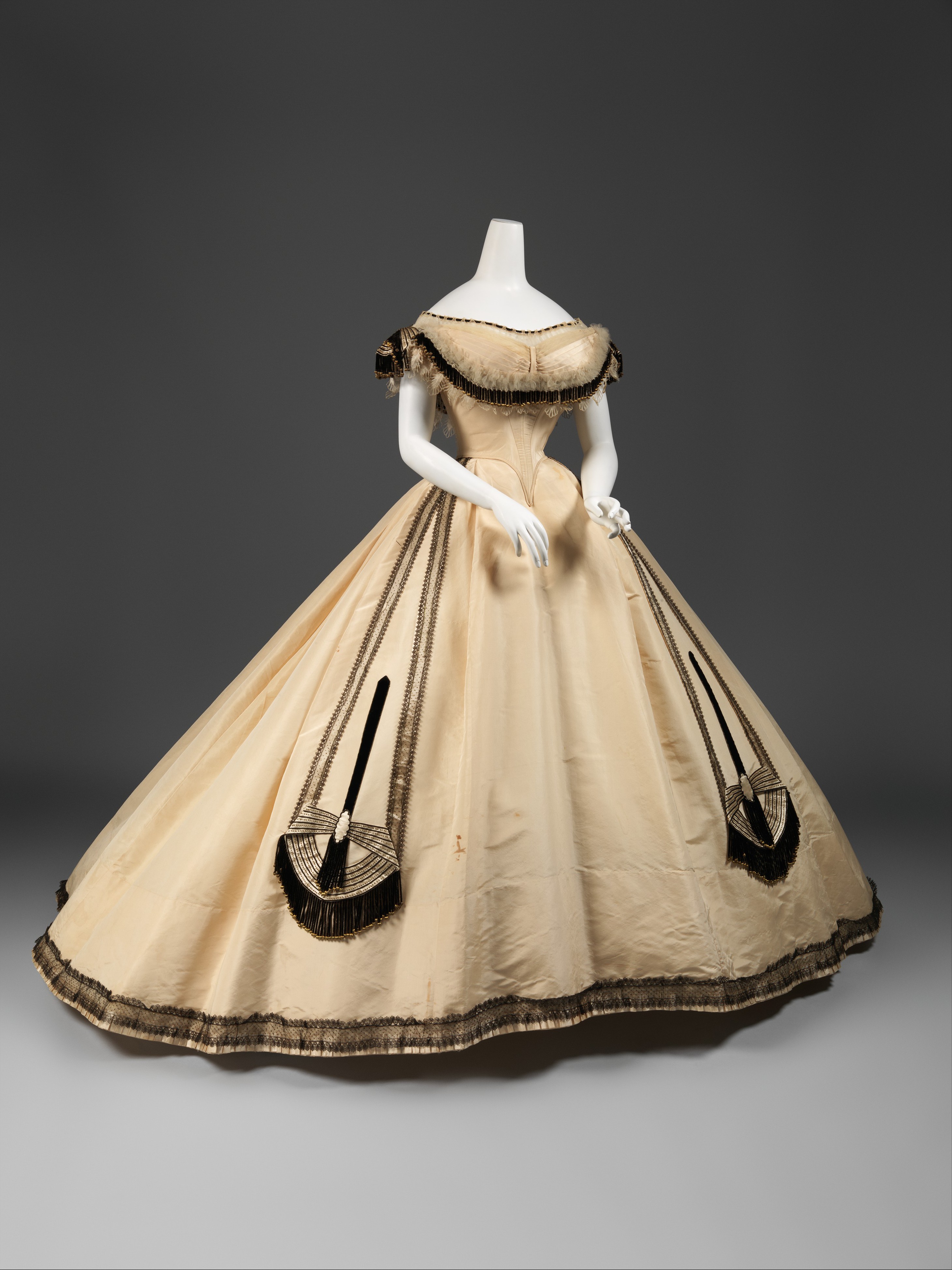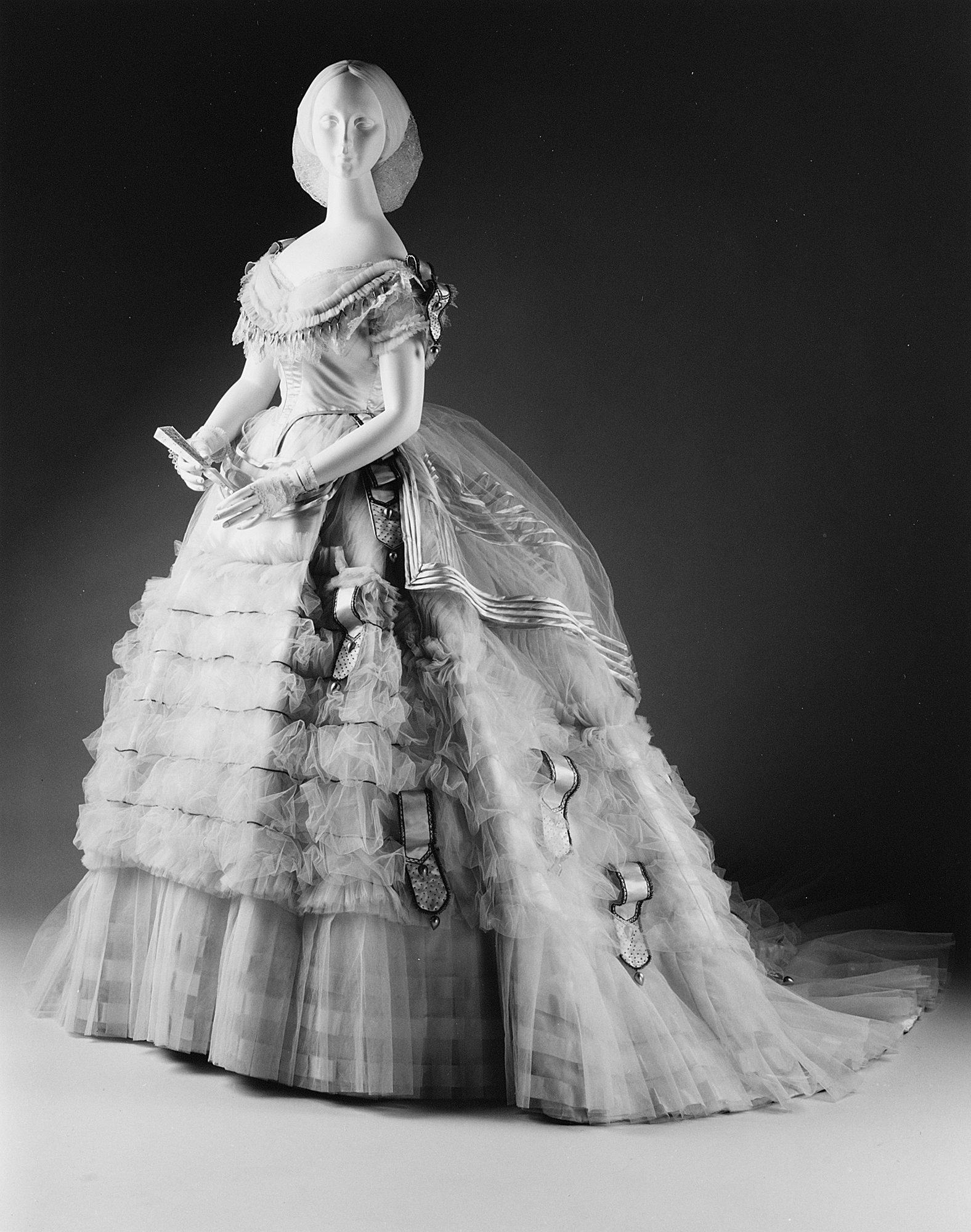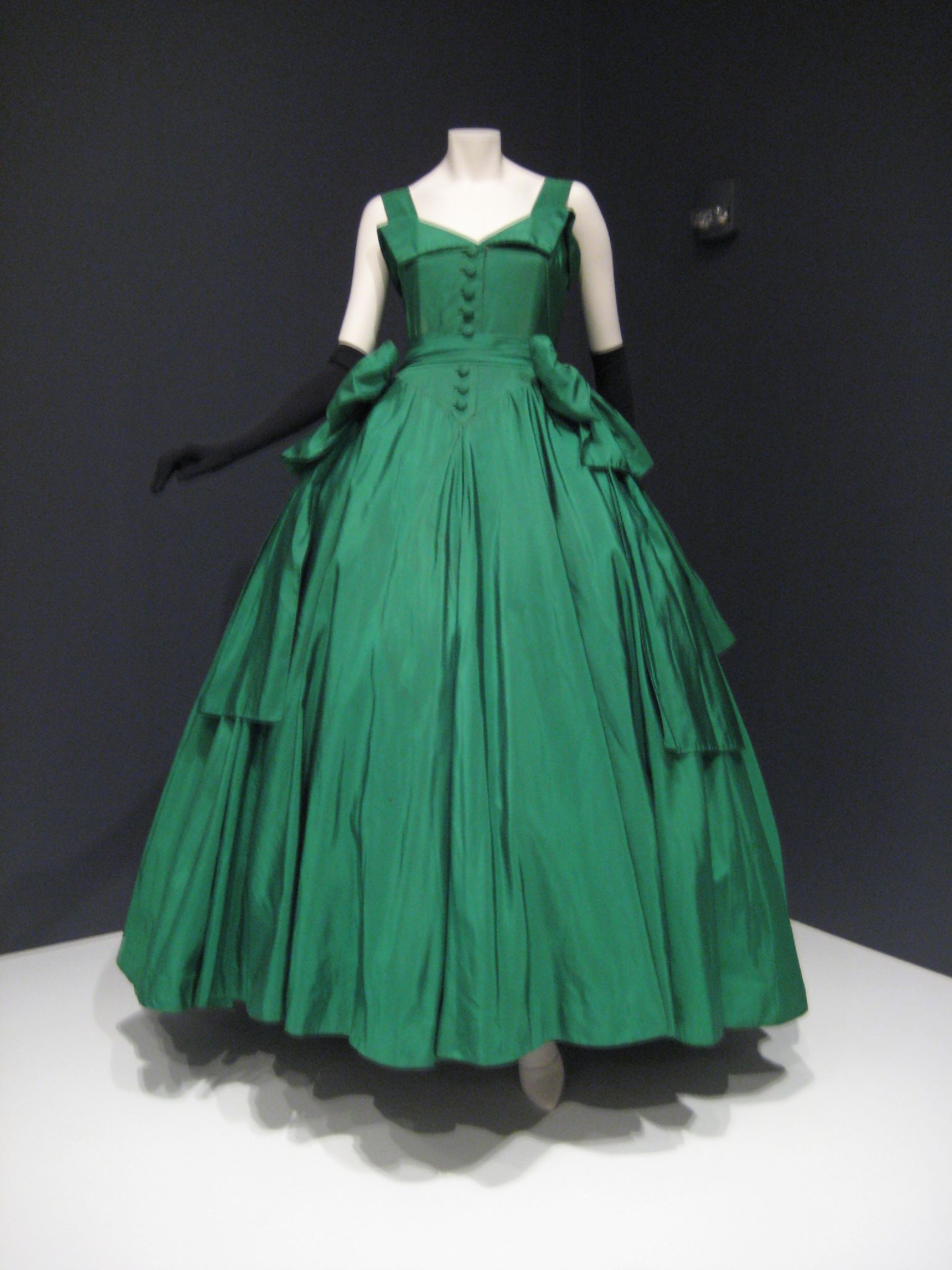Ball gown on:
[Wikipedia]
[Google]
[Amazon]
 A ball gown, ballgown or gown is a type of
A ball gown, ballgown or gown is a type of
 In previous years, the same type of dress might have been called an evening dress, having very similar features; low-cut neckline, a tight bodice, a large skirt and (sometimes) bare arms. The ball gown at this time had similar features, a full skirt supported by a
In previous years, the same type of dress might have been called an evening dress, having very similar features; low-cut neckline, a tight bodice, a large skirt and (sometimes) bare arms. The ball gown at this time had similar features, a full skirt supported by a 





 After the end of World War II, in 1947, Christian Dior introduced his "New Look" of nipped-in waistlines and full skirts.
After the end of World War II, in 1947, Christian Dior introduced his "New Look" of nipped-in waistlines and full skirts.
File:Modification de la taile1872 1877 1880.gif, The gown on the far right is an accurate representation of one that would be worn in 1880.
File:Illustrated fashion catalogue - summer, 1890 (1890) (14597303469).jpg, "Hourglass" shape of 1900
File:Buenos Aires - Eva Perón de gala en fundación del Teatro Colón.jpeg,
File:Debutantes having a dress rehearsal, February 2009.jpg,
File:Debutante-dress.jpg,
File:Agnes Melanie Dickson as a debutante, ca. 1890 (9306366314).jpg,
The traditional ideals of the debutante ball vary based on location in the United States. The debutantes in could be seen wearing jeweled crowns and dresses with Medici collars with elongated trains.
File:Quinceañera. Santa Fe (14369403262).jpg,
File:Quinceañeras 2011 - Pasarela (5580591293).jpg,
File:Pasarela de las "Quinceañeras del Bicentenario" (4458414368).jpg,
File:Quinceañera. Santa Fe (14184259179).jpg, Quinceanera photo from Santa Fe, New Mexico
File:Smithsonian National Museum of American History - Helen Tafts Inaugural Ball Gown (3425448486).jpg, Helen Taft's ball gown
File:Smithsonian National Museum of American History - Mamie Eisenhowers Evening Gown (3425451492).jpg,
 A ball gown, ballgown or gown is a type of
A ball gown, ballgown or gown is a type of evening gown
An evening gown, evening dress or gown is a long dress usually worn at formal occasions. The drop ranges from ballerina (mid-calf to just above the ankles), tea (above the ankles), to full-length. Such gowns are typically worn with evening ...
worn to a ball or a formal event. Most versions are cut off the shoulder with a low décolletage, exposed arms, and long bouffant
A bouffant () is a type of puffy, rounded hairstyle characterized by hair raised high on the head and usually covering the ears or hanging down on the sides.
Etymology
The English word ''bouffant'' comes from the French ''bouffante'', from ...
styled skirts. Such gowns are typically worn with an opera-length white gloves and vintage jewelry or couture, stole (a formal shawl in expensive fabric), cape
A cape is a clothing accessory or a sleeveless outer garment which drapes the wearer's back, arms, and chest, and connects at the neck.
History
Capes were common in medieval Europe, especially when combined with a hood in the chaperon. Th ...
or cloak
A cloak is a type of loose garment worn over clothing, mostly but not always as outerwear for outdoor wear, serving the same purpose as an overcoat, protecting the wearer from the weather. It may form part of a uniform. Cloaks have been and ...
in lieu of a coat. Where "state decoration
A state decoration is an object, such as a medal or the insignia of an order, that is awarded by a sovereign state to honor the recipient. The term includes:
*Civil awards and decorations
*Military awards and decorations
See also
* State order
...
s" are to be worn, they are on a bow pinned to the chest, and married women wear a tiara
A tiara (from la, tiara, from grc, τιάρα) is a jeweled head ornament. Its origins date back to ancient Greece and Rome. In the late 18th century, the tiara came into fashion in Europe as a prestigious piece of jewelry to be worn by women ...
if they have one. Although synthetic fabrics are now sometimes used, the most common fabrics are satin
A satin weave is a type of fabric weave that produces a characteristically glossy, smooth or lustrous material, typically with a glossy top surface and a dull back. It is one of three fundamental types of textile weaves alongside plain weave ...
, silk
Silk is a natural protein fiber, some forms of which can be woven into textiles. The protein fiber of silk is composed mainly of fibroin and is produced by certain insect larvae to form cocoons. The best-known silk is obtained from the ...
, taffeta
Taffeta (archaically spelled taffety or taffata) is a crisp, smooth, plain woven fabric made from silk, cuprammonium rayons, acetate, and polyester. The word is Persian (تافته) in origin and means "twisted woven". As clothing, it is used i ...
and velvet with trimmings of lace
Lace is a delicate fabric made of yarn or thread in an open weblike pattern, made by machine or by hand. Generally, lace is divided into two main categories, needlelace and bobbin lace, although there are other types of lace, such as knitted o ...
, pearls, sequins, embroidery
Embroidery is the craft of decorating fabric or other materials using a needle to apply thread or yarn. Embroidery may also incorporate other materials such as pearls, beads, quills, and sequins. In modern days, embroidery is usually seen ...
, ruffles, ribbons, rosettes and ruching.
History
1850s
 In previous years, the same type of dress might have been called an evening dress, having very similar features; low-cut neckline, a tight bodice, a large skirt and (sometimes) bare arms. The ball gown at this time had similar features, a full skirt supported by a
In previous years, the same type of dress might have been called an evening dress, having very similar features; low-cut neckline, a tight bodice, a large skirt and (sometimes) bare arms. The ball gown at this time had similar features, a full skirt supported by a petticoat
A petticoat or underskirt is an article of clothing, a type of undergarment worn under a skirt or a dress. Its precise meaning varies over centuries and between countries.
According to the ''Oxford English Dictionary'', in current British En ...
, a tight waist achieved by a corset or bodice
A bodice () is an article of clothing traditionally for women and girls, covering the torso from the neck to the waist. The term typically refers to a specific type of upper garment common in Europe during the 16th to the 18th century, or to the ...
with a stay to keep the subject upright and with perfect posture, off the shoulder style and with bare arms.
In the coming years, the introduction of the sewing machine changed the dress market. Middle-class people could now produce their own dresses and with more quality and efficiency than before when they were made by hand. Upper class members of society might still have had their dresses made by a designer but with the turn around time decreased. Around this time was also the introduction of chemical dyes. This dramatically changed the range of colors that dresses could be produced in. This time was encompassed within the Romantic period, which coincided with the Victorian era. During this time the crinoline was introduced as well as demure sleeves, which puffed up around the arm.

1860–1864
Skirts had developed an overall bell shape but with extra fullness at the back.
1865–1867
Skirts lost their front shape and were altered to lay more flat against the body while the sides and back gained fullness with pleating techniques. Oftentimes a long train was attached to the back of the skirt.1868–1878
For the next 10 years the fullness in the back of the skirts increased further with the use of thebustle
A bustle is a padded undergarment used to add fullness, or support the drapery, at the back of women's dresses in the mid-to-late 19th century. Bustles are worn under the skirt in the back, just below the waist, to keep the skirt from dragging. ...
.



1878–1884
The bustle went out of style because it was not needed anymore for the fullness in the back of the dress. The material instead was gathered and fell down the back which ended with a long train.1890–1900
The hourglass shape emerged which was known for a narrow waist. It was achieved by having a cone-shaped skirt that was narrow at the waist and gained fullness near the bottom.
 After the end of World War II, in 1947, Christian Dior introduced his "New Look" of nipped-in waistlines and full skirts.
After the end of World War II, in 1947, Christian Dior introduced his "New Look" of nipped-in waistlines and full skirts.
1950s
Previously, ball gowns were worn for private events and parties, but in the mid-20th century, private events turned into public ones. As the century progressed, traditional events became less important while ones like charity events took their place. In 21st century culture, galas and red carpet events are showcases for extravagant gowns to be in the public eye. In Britain, when Elizabeth II terminated formal court events in 1957, the more public events, like a charity ball, arose in popularity because they were open to anyone who could afford to buy a ticket. Designer dresses were typically part of a designer's collection, having them altered for the wearer. Designers need to know where a dress will be worn to avoid two people from matching. But if the original wearer decides to wear the dress to another event afterwards, the possibility of matching is increased. In modern times, designers must understand that their pieces of work will be criticized and also praised as a result of the internet and paparazzi.Gallery
Eva Perón
María Eva Duarte de Perón (; ; 7 May 1919 – 26 July 1952), better known as just Eva Perón or by the nickname Evita (), was an Argentine politician, activist, actress, and philanthropist who served as First Lady of Argentina from June 19 ...
wearing a gown by Christian Dior, 1950
File:Two Jean Dessès evening gowns, 1951.jpg, Two Jean Dessès
Jean Dessès (6 August 1904 – 2 August 1970) was a world leading fashion designer in the 1940s, 1950s and 1960s. His designs reflected the influences of his travels, specializing in creating draped evening gowns in chiffon and mousseline, b ...
ball gowns, 1951
Culture
The first forms of the 21st century term “debutante ball
A debutante ball, sometimes called a coming-out party, is a formal ball that includes presenting debutantes during the season, usually during the spring or summer. Debutante balls may require prior instruction in social etiquette and appropriate ...
” or “cotillion
The cotillion (also cotillon or French country dance) is a social dance, popular in 18th-century Europe and North America. Originally for four couples in square formation, it was a courtly version of an English country dance, the forerunner ...
” emerged in the mid 19th century with what was called a “coming out ball”. These events were meant to show off the women who were now of marriageable age. Traditionally the debutantes will wear all white, but with varying styles of dress. While the style of dress can vary, strapless and sleeveless variations are popular and are typically worn with white long gloves and can be accessorized with bouquets, and sometimes a fan. For most of the 19th century, a headdress with veiling was a popular style as well as a full train attached at the waist and in later years it would attach to the shoulders.Texas
Texas (, ; Spanish: ''Texas'', ''Tejas'') is a state in the South Central region of the United States. At 268,596 square miles (695,662 km2), and with more than 29.1 million residents in 2020, it is the second-largest U.S. state by ...
has variations within its various regions. In Laredo, middle class debutantes wear beaded suede garments. In San Antonio, the dresses are of elaborate colors and covered in beads of different designs. The beads add extensive weight having some dresses weigh in at about 75 lbs.
Another coming of age event is the quinceañera, an event in Latin American cultures when a girl turns 15. Their gowns are often very brightly colored and resemble traditional ball gowns with very full ruffled or ruched skirts.First Ladies Collection
In 1912, Helen Taft along with collection founders Cassie Mason Myers Julian-James, Rose Gouverneur Hoes, and the Smithsonian Institution started the “First Ladies Collection.” It is customary for the first lady of the United States to donate the dress she wears to the inauguration ball but it is not required. Every first lady is represented in the collection although they are not all inaugural dresses. Mrs. Taft started this tradition when she donated her dress that she wore during President Taft's inauguration. Typically the dresses were added to the collection after the first lady had left office but in 1955 the public uproar to seeMamie Eisenhower
Mary Geneva "Mamie" Eisenhower (; November 14, 1896 – November 1, 1979) was the first lady of the United States from 1953 to 1961 as the wife of President Dwight D. Eisenhower. Born in Boone, Iowa, she was raised in a wealthy household i ...
's inaugural dress was so strong that the Smithsonian changed their policy and added her dress immediately, not waiting until she left office.Mamie Eisenhower
Mary Geneva "Mamie" Eisenhower (; November 14, 1896 – November 1, 1979) was the first lady of the United States from 1953 to 1961 as the wife of President Dwight D. Eisenhower. Born in Boone, Iowa, she was raised in a wealthy household i ...
's ball gown
File:Hearth Truth red dresses.jpg,
See also
* Ball (dance) *Ballerina skirt A ballerina skirt is commonly referred to as a Juliet skirt or a romance skirt. It can be defined as a full skirt that is worn by ballet dancers and is composed of multiple layers of fabric. Ballet dancers wear the longer version of the skirt, while ...
*Crinoline
A crinoline is a stiff or structured petticoat designed to hold out a woman's skirt, popular at various times since the mid-19th century. Originally, crinoline described a stiff fabric made of horsehair ("crin") and cotton or linen which was ...
*Clothing terminology
Clothing terminology comprises the names of individual garments and classes of garments, as well as the specialized vocabularies of
the trades that have designed, manufactured, marketed and sold clothing over hundreds of years.
Clothing termi ...
*Dress codes
A dress code is a set of rules, often written, with regard to what clothing groups of people must wear. Dress codes are created out of social perceptions and norms, and vary based on purpose, circumstances, and occasions. Different societies an ...
References
Further reading
* {{Clothing 19th-century fashion 20th-century fashion 21st-century fashion Dancewear Gowns History of clothing (Western fashion) History of fashion Balls (dance party)